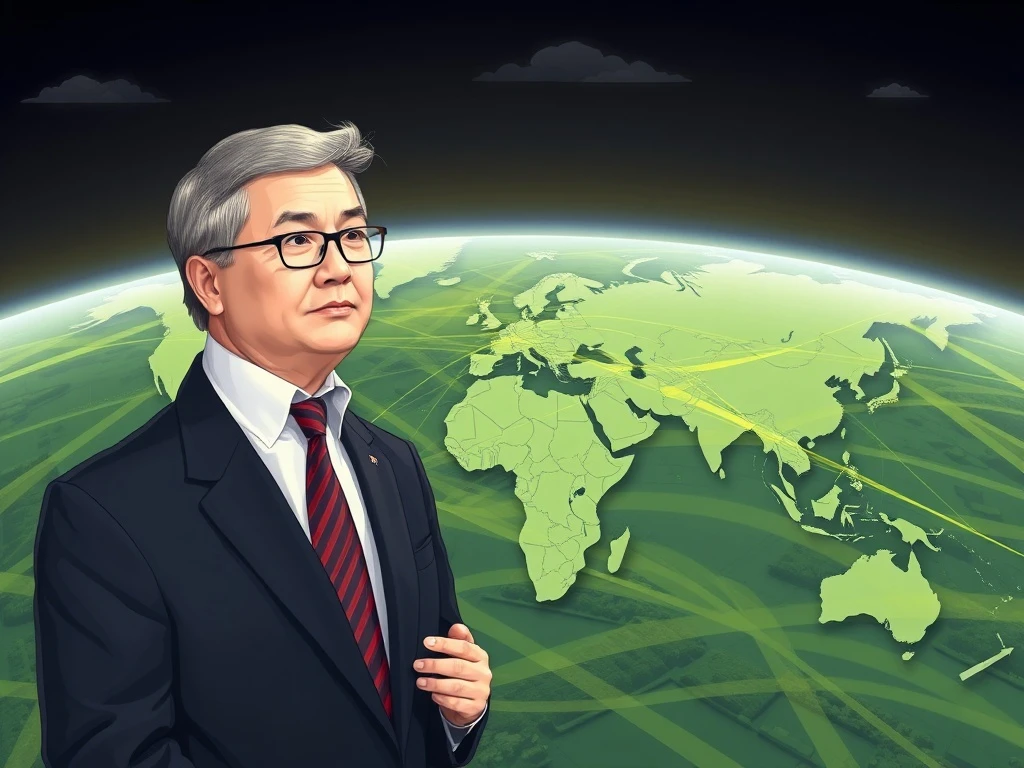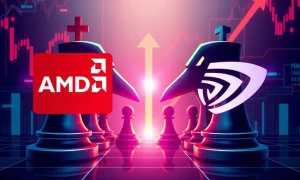The intersection of technology and geopolitics profoundly shapes global economies. Therefore, the dynamics of Nvidia Trump trade have quietly emerged as a significant area of focus. Jensen Huang, Nvidia’s visionary CEO, has navigated complex international relations with remarkable skill. His leadership has positioned Nvidia at the forefront of the semiconductor industry. This critical position, however, brings unique challenges. It also creates unexpected alignments in global trade. This article explores the nuanced relationship between Nvidia’s strategic corporate moves and the trade policies enacted during the Trump administration. We will examine how this ‘silent partnership’ has influenced technological development and international commerce. Understanding this interplay is crucial for anyone interested in business and entrepreneurship.
Nvidia’s Ascendance and Jensen Huang’s Vision
Nvidia’s journey from a graphics card innovator to a dominant AI chipmaker is truly remarkable. Jensen Huang’s foresight propelled this incredible transformation. He recognized the immense potential of parallel computing early on. This vision extended far beyond gaming. It moved into data centers, artificial intelligence, and autonomous vehicles. Consequently, Nvidia’s technologies became indispensable globally. Its market capitalization soared, reflecting its critical role in the digital age. The company’s advanced semiconductors now power countless artificial intelligence breakthroughs. They also underpin vast cloud computing infrastructures worldwide. This technological dominance makes Nvidia a crucial player in global economic stability. Furthermore, it positions the company directly within the purview of national trade strategies. The rapid growth of Nvidia has made it a central figure in global tech discussions.
The Geopolitical Chessboard and Nvidia Trump Trade
Global trade has become increasingly intertwined with national security concerns. The semiconductor industry, specifically, sits at the epicenter of this shift. Advanced chips are vital for modern military applications. They are also essential for critical national infrastructure. Therefore, governments worldwide view their semiconductor supply chains as strategic assets. The Trump administration, in particular, strongly emphasized securing domestic technological advantages. This approach often involved tariffs, export controls, and restrictions on foreign competitors. Such policies directly impacted major companies like Nvidia. They forced tech giants to re-evaluate their entire global operations. The broader implications for Nvidia Trump trade relations quickly became evident. Companies had to adapt rapidly to new geopolitical realities. This period marked a significant shift in international commerce.
Trump’s Trade Policies: A Retrospective
The Trump administration initiated a significant shift in U.S. trade policy. Its ‘America First’ agenda prioritized domestic industries above all else. This involved imposing tariffs on goods from key trading partners. China, in particular, faced substantial economic pressure. The administration aimed to reduce trade deficits. It also sought to protect American intellectual property. Export controls on sensitive technologies became a key tool as well. These measures sought to limit the technological advancement of rival nations. For instance, restrictions targeted specific Chinese tech companies. This created a complex and often unpredictable environment for global businesses. Nvidia, with its extensive international supply chain and customer base, felt these direct impacts acutely. Navigating these new policies required exceptional strategic acumen and adaptability. The administration’s actions reshaped global commerce significantly.
Key aspects of the Trump administration’s trade policy included:
- Tariff Implementation: Broad tariffs applied to various imported goods, aiming to protect U.S. manufacturers and reduce trade imbalances.
- Trade Deficit Reduction: A primary goal was to shrink the U.S. trade deficit with major partners, especially China.
- Intellectual Property Protection: Aggressive measures sought to combat intellectual property theft, particularly from foreign entities.
- Export Controls: Restrictions placed on the sale of advanced technologies to certain foreign entities, driven by national security concerns.
Nvidia’s Strategic Maneuvers Under Pressure
Nvidia faced considerable challenges during this period of heightened trade tensions. The company relied heavily on global manufacturing and sales. New tariffs increased costs and reduced market access. Export controls threatened crucial revenue streams. Jensen Huang, however, adopted a remarkably pragmatic approach. Nvidia actively **diversified its supply chain** where possible. For example, it explored manufacturing options in Taiwan and other Asian countries beyond mainland China. It also sought new markets and partnerships to offset losses in restricted areas. The company actively engaged with policymakers in Washington D.C. This engagement aimed to advocate for balanced regulations. Furthermore, Nvidia emphasized its unwavering commitment to **innovation and research and development**. This strategy helped mitigate some adverse effects, ensuring the company maintained its technological edge. It allowed Nvidia to continue its remarkable growth trajectory despite the headwinds. The complex interplay between corporate strategy and government policy clearly defined the Nvidia Trump trade era. This period proved crucial for Nvidia’s long-term resilience and adaptability.
The ‘Silent Partner’ Dynamics in Nvidia Trump Trade
The term ‘silent partner’ describes a nuanced relationship, not a formal alliance. It suggests an indirect but significant influence. Jensen Huang did not overtly endorse specific political policies. Yet, Nvidia’s technological advancements inherently aligned with certain national interests. The U.S. government sought to maintain a decisive lead in AI and advanced computing. Nvidia’s cutting-edge chips were absolutely central to achieving this goal. Consequently, the company’s success inadvertently served broader national strategic objectives. This dynamic created a symbiotic, if unstated, partnership. Nvidia’s relentless innovation bolstered U.S. tech leadership globally. In return, its strategic importance sometimes offered a degree of protection or at least a listening ear from government officials. This informal alignment significantly characterized the Nvidia Trump trade landscape. It demonstrated how critical technology companies become integral to national strategy, even without direct political affiliation. This subtle relationship highlights the complexities of modern geopolitics.
Impact on the Semiconductor Industry
The semiconductor industry is highly globalized. Therefore, trade policies have ripple effects across its complex ecosystem. Restrictions on one company can impact many others throughout the supply chain. The pressures of the Nvidia Trump trade era led to industry-wide adjustments. Companies started exploring domestic manufacturing options more seriously. They also invested more heavily in research and development to secure future capabilities. This push aimed to reduce reliance on potentially unstable foreign supply chains. Furthermore, governments around the world increased subsidies for chip production. The goal was to secure national self-sufficiency in critical technologies. This period accelerated a trend towards regionalization in semiconductor manufacturing. It reshaped the competitive landscape significantly. The industry continues to grapple with these shifts.
Global Supply Chains and Resilience
The events of the Trump administration highlighted significant vulnerabilities in global supply chains. Companies realized the urgent need for greater resilience. Nvidia, like many others, began to diversify its manufacturing base. This involved exploring new production sites outside traditional hubs. Building redundant supply lines became a top priority. The goal was to mitigate risks from political tensions or natural disasters. These strategic shifts required significant investment. They also necessitated closer collaboration with various international partners. Ultimately, the focus moved from pure efficiency to robust security. The lessons learned during the intense Nvidia Trump trade period continue to influence corporate strategy today. Businesses worldwide are now more conscious of geopolitical risks.
Future Outlook and Potential Scenarios for Nvidia Trump Trade
The relationship between tech giants and government policy remains highly dynamic. Future administrations may adopt different trade approaches. However, the foundational importance of semiconductors persists. Nvidia’s role in AI and advanced computing will likely only grow. This ensures its continued relevance in geopolitical discussions. Companies must remain agile. They need to adapt quickly to evolving regulatory environments. Potential scenarios include further decoupling of tech economies. Alternatively, renewed efforts for international cooperation could emerge. The legacy of the Nvidia Trump trade era provides valuable insights. It demonstrates how corporate leadership can successfully navigate complex geopolitical landscapes. The semiconductor industry will undoubtedly remain a key battleground in global trade and national security.
Conclusion
Jensen Huang’s leadership at Nvidia has been instrumental. He successfully guided the company through a turbulent period of trade policy. The implied ‘silent partnership’ with the Trump administration was not a formal alliance. Instead, it represented a convergence of strategic interests. Nvidia’s technological prowess bolstered U.S. competitiveness in critical areas. Simultaneously, the company navigated restrictive trade measures with great skill. This complex interplay profoundly reshaped global tech dynamics. It also underscored the vital connection between innovation and national policy. The Nvidia Trump trade narrative highlights how private sector innovation can influence geopolitical outcomes. It emphasizes the ongoing need for adaptive strategies in an increasingly globalized and interconnected world. Businesses must be prepared for similar challenges.
Frequently Asked Questions (FAQs)
Q1: What is the ‘silent partnership’ between Nvidia CEO Jensen Huang and Trump?
A1: The ‘silent partnership’ refers to an indirect alignment of interests. While not a formal alliance, Nvidia’s advancements in AI and semiconductors inadvertently supported U.S. strategic goals during the Trump administration. This convergence made Nvidia a critical, if unstated, asset in trade discussions.
Q2: How did Trump’s trade policies specifically impact Nvidia?
A2: Trump’s trade policies, including tariffs and export controls, increased Nvidia’s operational costs and threatened access to key markets. These policies necessitated strategic adjustments, such as supply chain diversification and intensified lobbying efforts.
Q3: What strategies did Nvidia employ to navigate trade tensions?
A3: Nvidia diversified its global supply chain, explored new international markets, and actively engaged with U.S. policymakers. The company also maintained a strong focus on innovation and research to stay ahead of competitors and mitigate policy impacts.
Q4: Why is the semiconductor industry so central to geopolitical trade discussions?
A4: Semiconductors are fundamental to modern technology, including AI, defense systems, and critical infrastructure. Their strategic importance makes control over their supply chain a national security priority, leading to intense geopolitical competition and trade discussions.
Q5: What does the ‘Nvidia Trump trade’ dynamic imply for future tech policy?
A5: This dynamic implies that technology companies will continue to be integral to national security and trade policy. Future administrations may adopt different approaches, but the strategic importance of tech leadership, particularly in semiconductors, will likely ensure ongoing government involvement and scrutiny.
Q6: How did Nvidia’s supply chain adapt during this period?
A6: Nvidia adapted by actively diversifying its manufacturing base and exploring new production sites outside traditional hubs. This strategic shift aimed to build greater resilience and reduce reliance on potentially unstable regions, ensuring continuity amidst trade uncertainties.








